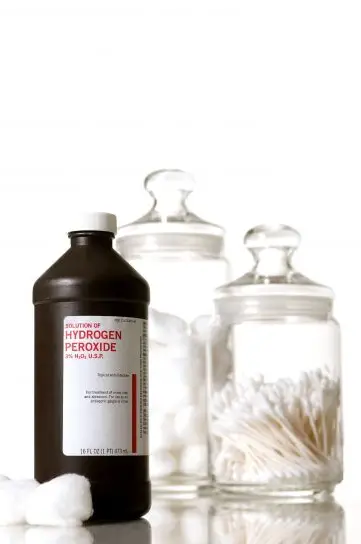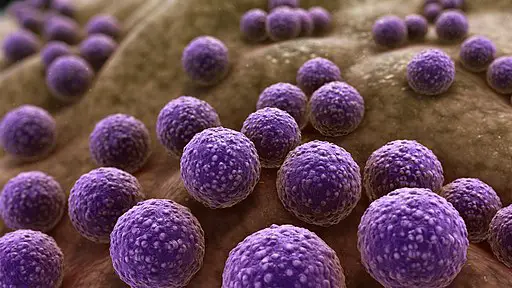Does Peroxide Kill Bacteria?
Peroxide may be described as a chemical compound that has two Oxygen atoms linked by a single covalent bond. Generally, peroxides can be classified as organic or inorganic. Organic peroxides have carbon (organic compounds like 2-butanone peroxide) while inorganic peroxides, like hydrogen peroxide, do not.
Due to the fact that peroxides can undergo different types of reactions (oxidation, reduction, etc.), they have a number of applications which include bleaching (e.g. bleaching pulp and textile, etc.), cosmetics, cleaning, oral hygiene, etc.
By producing highly-reactive hydroxyl radicals, the chemical can also rapidly kill different types of cells. For this reason, it's sometimes (though not recommended) used as a mild antiseptic.
* The functional group of peroxide is represented as - ROOR
Some other examples of peroxides include:
- Tetrahydrofuran hydroperoxide
- Carbamide peroxide
- Sodium peroxide
- Barium peroxide
Though peroxides can kill different types of cells, including bacteria, some bacteria species have a way of protecting themselves against the harmful effects of this chemical.
Staphylococci response to Peroxide
With the exception of a few species (e.g. Staphylococcus aureus and Staphylococcus saccharolyticus), the majority of Staphylococcus species are catalase positive. This means that they have the enzyme catalase. Also found in many other aerobic organisms, catalase is an antioxidant enzyme that is involved in the breakdown of hydrogen peroxide to release water and oxygen.
In higher plants, the enzyme can be found in the cytosol, chloroplast, peroxisomes, and the mitochondria where hydrogen peroxide is produced through various chemical reactions. This prevents the buildup of peroxide which is toxic and can cause cell death.
* Some bacteria (E.g. Streptococcus sanguinis and Lactobacilli) have been shown to produce hydrogen peroxide as a strategy of competing against other bacteria. By producing the peroxide, they inhibit the growth of other pathogens in different parts of the body.
For instance, the hydrogen peroxide produced by Streptococcus sanguinis in the mouth inhibits/kills other bacteria thus allowing the bacterium to thrive with little competition.
* Hydrogen peroxide produced by certain Lactobacilli has been shown to inhibit Staphylococcus aureus and Pseudomonas.
While catalase protects the Staphylococci bacteria from the peroxide they produce, it also protects them from the peroxide produced by the cells of the host. For instance, the bacterium Staphylococcus aureus is a facultative intracellular pathogen. As such, it can invade and replicate in various host cells (E.g. phagocytic cells).
Given that hosts cells also produce hydrogen peroxide, the synthesis and production of the enzyme catalase protect the bacterium against this chemical. In general, the reaction (catalase and hydrogen peroxide reactions) is divided into two parts.
In the first part of the reaction, the hydrogen peroxide is bound to the heme group of the enzyme (catalase) resulting in the oxidation of iron (FeIV). However, this also results in the production of water and an oxygen atom. In the second part of the reaction, the enzyme once again breaks the second hydrogen peroxide molecule resulting in two molecules of water and one of oxygen.
* Aside from the enzyme catalase, bacteria like S. aureus have also been shown to produce a number of additional factors against hydrogen peroxide. These include the enzyme alkyl hydroperoxide reductase as well as DNA-binding proteins.
Whereas alkyl hydroperoxide reductase (AhpC) serves to decompose hydrogen peroxide, like catalase, DNA-binding proteins (Dps) function by inhibiting the production of hydroxyl radical from the peroxide.
How Peroxide kills Bacteria Cells
While some bacteria produce a variety of factors that protect them against the negative effects of peroxide, others do not. For this reason, they can be easily destroyed when exposed to this chemical.
In plants and mammals, studies have shown that certain aquaporins help to facilitate the movement of hydrogen peroxide across the membrane. Over time, this results in the destruction of the membrane as well as damage to nuclear and mitochondrial DNA damage.
In many bacteria, diffusion of peroxide across the membrane is limited. However, peroxide can still damage and kill the cell by targeting various structural components.
See further articles about bacteria:
Bacteriology as a field of study
Bacterial Transformation, Conjugation
How do Bacteria cause Disease?
Bacteria - Size, Shape and Arrangement - Eubacteria
Mechanism of Action (Impact of Peroxides on Bacteria)
Peroxides like hydrogen peroxide can produce oxygen species (Hydroxyl radical). In doing so, they can cause significant damage to various components of the cell including lipids, proteins, and nucleic acids.
In studies involving E. coli, low concentrations of hydrogen peroxide was shown to cause significant cell filamentation. Despite this, researchers noticed a significant decrease in cell volume at higher concentrations. These results were attributed to the impact of the peroxide on the cell membrane and the loss of various intracellular materials.
With the bacterium Cyanobacterium aphanizomenon, a high concentration of hydrogen peroxide was shown to result in the release of dissolved organic compounds indicating damage to the cell membrane.
Aside from the direct impact of hydrogen peroxide on bacterial cell wall and membrane through the generation of hydroxyl radicals, studies have also shown the chemical to kill some bacteria through the lactoperoxidase system.
Also known as the lactoperoxidasethiocyanate-H202 antimicrobial system (LP system), this mode of action has been detected in a number of fluids including raw milk, saliva, and tears, etc.
Though this mechanism can kill some bacteria, it's more active against Gram-negative bacteria (within a thinner cell wall) than Gram-positive bacteria. Here, the enzyme lactoperoxidase is involved in the oxidation of thiocyanate ions in the presence of hydrogen peroxide resulting in the production of hypothiocyanite. This is a relatively weak oxidizing agent characterized by bacteriostatic activity.
In the upper respiratory tract of calves (in abomasum fluid), this mode of action has been shown to inhibit the growth and proliferation of the bacterium E. coli.
Read more about Gram positive and Gram negative bacteria.
* The combination of UV radiation and hydrogen peroxide has also been shown to be effective in the destruction of bacterial spores.
* For bacteria without catalase enzymes and glutathione peroxidase, they can repair the cell membrane if they were exposed to peroxide for a short period of time and at low concentrations.
* Inside the cell, hydrogen peroxide has been shown to degrade DNA and alter processes like DNA methylation. This affects cellular processes and ultimately results in cell death.
* While hydrogen peroxide can kill certain bacteria, it's worth noting that it also destroys normal cells. For this reason, it's discouraged as an antiseptic particularly because it affects wound healing.
How do Antibiotics kill Bacteria?
Does Salt Water kill Bacteria?
List of Diseases caused by Bacteria
Return from Does Peroxide kill Bacteria? to MicroscopeMaster home
References
A Dezfulian et al. (2010). Catalase-negative Staphylococcus aureus isolated from a diabetic foot ulcer.
Benjamin J. Juven and Merle D. Pierson. (1996). Antibacterial Effects of Hydrogen Peroxide and Methods for Its Detection and Quantitationt.
Ezra Linley et al., (2012). Use of hydrogen peroxide as a biocide: new consideration of its mechanisms of biocidal action.
Links
https://www.sciencedirect.com/topics/agricultural-and-biological-sciences/catalase
https://www.sciencedirect.com/topics/chemistry/peroxide
Find out how to advertise on MicroscopeMaster!






